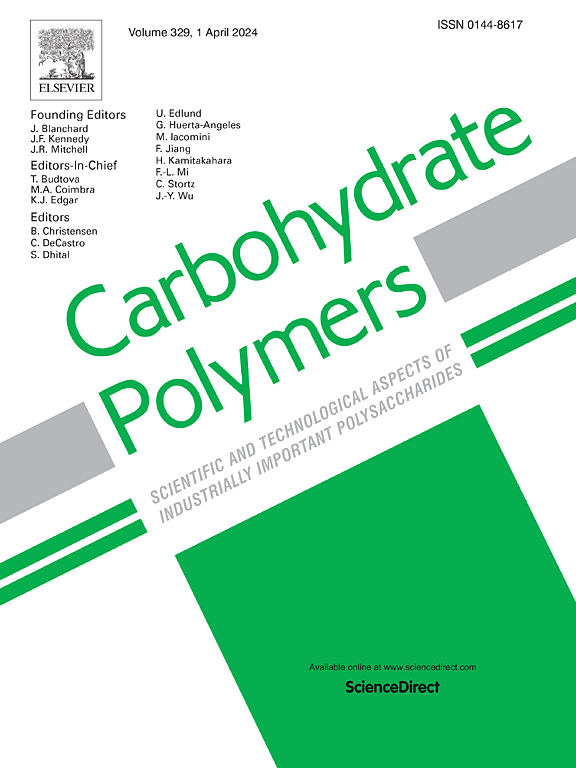Structural characterization and therapeutic potential of exopolysaccharide EPS-W-1 from Lactiplantibacillus plantarum strain ZL1 isolated from kimchi against DSS-induced colitis
IF 10.7
1区 化学
Q1 CHEMISTRY, APPLIED
引用次数: 0
Abstract
Ulcerative colitis (UC) is associated with intestinal barrier dysfunction, gut microbiome (GM) dysbiosis, inflammation, and immune dysregulation. Lactic acid bacteria-derived exopolysaccharides (LAB-EPS) have biotherapeutic potential to stimulate immune responses and influence the GM. Therefore, this work aimed to extract the bioactive EPS (EPS-W-1) from Lactiplantibacillus plantarum ZL1, isolated from Korean kimchi, and then characterize the chemical structure of EPS-W-1 using HPLC, GC–MS, and NMR. The effect of EPS-W-1 treatment on the UC mice was evaluated. The composition of EPS-W-1 was rhamnose (5.06 %), galactose (25.79 %), glucose (53.37 %), and mannose (10.93 %), and its molecular weight (MW) was 260.34 kDa. The colon length increased in the treatment group H-EPS-W-1 (8.9 cm) compared to the DSS group (4.46 cm). In addition, the H-EPS-W-1 treatment improved histological architecture, regulated the GM, and triggered the higher generation of short-chain fatty acids (SCFAs) than the DSS group. It also modulated immune responses by downregulating IL-6 (−48.64 %) and TNF-α (−60.25 %), while upregulating IL-10 (+107.43 %). Collectively, these findings suggest that EPS-W-1 possesses significant therapeutic potential in ameliorating UC through modulation of the GM and regulation of the immune system.

泡菜中植物乳杆菌ZL1株外多糖EPS-W-1的结构特征及对dss诱导结肠炎的治疗潜力
溃疡性结肠炎(UC)与肠屏障功能障碍、肠道微生物群(GM)生态失调、炎症和免疫失调有关。乳酸菌衍生的胞外多糖(LAB-EPS)具有刺激免疫应答和影响GM的生物治疗潜力。因此,本研究旨在从韩国泡菜中分离的植物乳杆菌ZL1中提取具有生物活性的EPS (EPS- w -1),并利用HPLC、GC-MS和NMR对EPS- w -1的化学结构进行表征。观察EPS-W-1对UC小鼠的影响。EPS-W-1的主要成分为鼠李糖(5.06%)、半乳糖(25.79%)、葡萄糖(53.37%)和甘露糖(10.93%),分子量为260.34 kDa。与DSS组(4.46 cm)相比,治疗组H-EPS-W-1结肠长度增加(8.9 cm)。此外,H-EPS-W-1处理改善了组织结构,调节了GM,并触发了比DSS组更高的短链脂肪酸(SCFAs)的生成。它还通过下调IL-6(- 48.64%)和TNF-α(- 60.25%),上调IL-10(+ 107.43%)来调节免疫应答。总之,这些发现表明EPS-W-1通过调节GM和调节免疫系统在改善UC方面具有显著的治疗潜力。
本文章由计算机程序翻译,如有差异,请以英文原文为准。
求助全文
约1分钟内获得全文
求助全文
来源期刊

Carbohydrate Polymers
化学-高分子科学
CiteScore
22.40
自引率
8.00%
发文量
1286
审稿时长
47 days
期刊介绍:
Carbohydrate Polymers stands as a prominent journal in the glycoscience field, dedicated to exploring and harnessing the potential of polysaccharides with applications spanning bioenergy, bioplastics, biomaterials, biorefining, chemistry, drug delivery, food, health, nanotechnology, packaging, paper, pharmaceuticals, medicine, oil recovery, textiles, tissue engineering, wood, and various aspects of glycoscience.
The journal emphasizes the central role of well-characterized carbohydrate polymers, highlighting their significance as the primary focus rather than a peripheral topic. Each paper must prominently feature at least one named carbohydrate polymer, evident in both citation and title, with a commitment to innovative research that advances scientific knowledge.
 求助内容:
求助内容: 应助结果提醒方式:
应助结果提醒方式:


